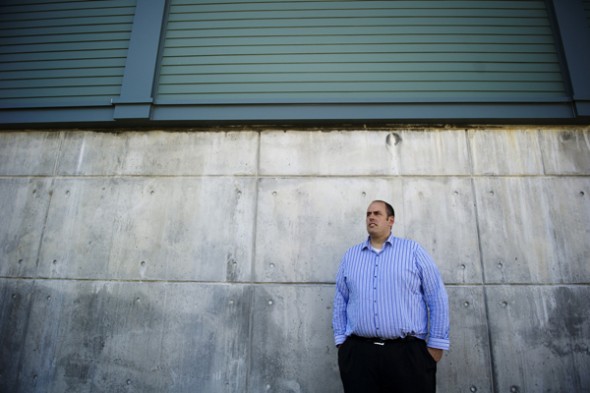Better science for better fisheries management

Marine science researcher Jon Grabowski works across and disciplines to come up with the best habitat management strategies for fisheries and the communities that depend on them. Photo by Mariah Tauger.
But the big concern is really one of culture, according to Northeastern’s Jon Grabowski. “You’re talking about an iconic fishery. Cod has been fished in these waters going back hundreds and hundreds of years,” said Grabowski, an associate professor of marine and environmental science at the university’s Marine Science Center in Nahant, Massachusetts. “You can go back a thousand years to the Basques coming over to fish these historically really productive grounds,” he said.
Grabowski, has been working with other fisheries scientists as well as economists, social scientists, and policy makers to determine the best strategies for dealing with the all of the Northeast region’s fisheries that impact habitat, which includes cod, haddock, cusk, scallops, clams and other fish that live near the sea floor and are of significant socioeconomic value to the region.
In the first of a series of research articles produced by the PDT, Grabowski and his colleagues examine the vulnerability of groundfish habitats to various types of fishing gear. “We reviewed how all the different geological and biological components of habitat are affected by these different types of gear,” Grabowski said. The committee examined how easily these habitats can be damaged and how long it takes for them to recover.
They found that mobile fishing gear such as trawls and dredges that drag along the bottom cause more damage to areas inhabited by groundfish than stationary gear like traps and gillnets. They also found that larger geological features, such as cobble and boulders, are more susceptible to damage and take longer to recover than sand and mud—after all, some of these geological features have taken millennia to form.
The research, published online last month in the journal Reviews in Fisheries Science & Aquaculture, uses these results to develop a framework that will provide fisheries managers a standardized method for identifying the most vulnerable habitats. Their work is being used as part of the Second Habitat Omnibus to inform redesigning the fishing closures on Georges Bank and in the Gulf of Maine.
“We worry most about the components of habitats that are highly susceptible to any of these gears and that have very long recovery times. Those are the kinds of persistent and severe impacts that we’d want to manage against,” Grabowski said. His research focuses on the many interconnecting arms of fisheries science and management.
Grabowski said there are many stakeholders involved when dealing with complex challenges like New England’s fishery problems. His approach focuses on interdisciplinary solutions to these challenges by examining not just the basic ecology of these species and their habitats, but also the ways in which the coastal communities are reacting to how fisheries are managed.
Grabowski compared himself to a cod—a generalist in the marine world—since he works across traditional institutional and sectorial boundaries to identify the best strategies and find ways to effectively implement them.
“At the end of the day,” Grabowski said, “if we really want to do something about sustainability, we must be doing the kinds of things that involve policy and help shape the way society self regulates.”
Media Contact
More Information:
http://www.northeastern.edu/news/2014/05/grabowski/All latest news from the category: Ecology, The Environment and Conservation
This complex theme deals primarily with interactions between organisms and the environmental factors that impact them, but to a greater extent between individual inanimate environmental factors.
innovations-report offers informative reports and articles on topics such as climate protection, landscape conservation, ecological systems, wildlife and nature parks and ecosystem efficiency and balance.
Newest articles

Long-sought structure of powerful anticancer natural product
…solved by integrated approach. A collaborative effort by the research groups of Professor Haruhiko Fuwa from Chuo University and Professor Masashi Tsuda from Kochi University has culminated in the structure…

Making a difference: Efficient water harvesting from air possible
Copolymer solution uses water-loving differential to induce desorption at lower temperatures. Harvesting water from the air and decreasing humidity are crucial to realizing a more comfortable life for humanity. Water-adsorption…

In major materials breakthrough
UVA team solves a nearly 200-year-old challenge in polymers. UVA researchers defy materials science rules with molecules that release stored length to decouple stiffness and stretchability. Researchers at the University…



